“Libelle, there are six uninjured people near Martin Busch Hütte in need of evacuation from steep terrain,” comes the scramble message from Tirol’s Emergency Coordination Center over the digital radio for the Austrian Police Air Support base in Innsbruck.

Pilot Hans Schlager and operator-rescuer Franz Markart don’t waste a second. Their polished Airbus AS350 B1 is pushed out of the hangar, helmets are put on, rescue coordinates entered into the moving map, and in less than three minutes we’re airborne towards the majestic panorama of the Otztal Alps.
“Police Mike after takeoff, direction Vent,” Schlager states briefly as he scrolls through the moving map on his Apple iPad to find the coordinates close to the little village of Vent.
“Police Mike, roger, QNH 1014, proceed south of the airport and report leaving the CTR,” confirms Innsbruck Tower, as the air base is situated next to the runway of the Innsbruck International Airport, known worldwide for its spectacular but difficult approaches. It gets busy here during the winter and summer high seasons, and rescue helicopter traffic requires precise coordination in special corridors.
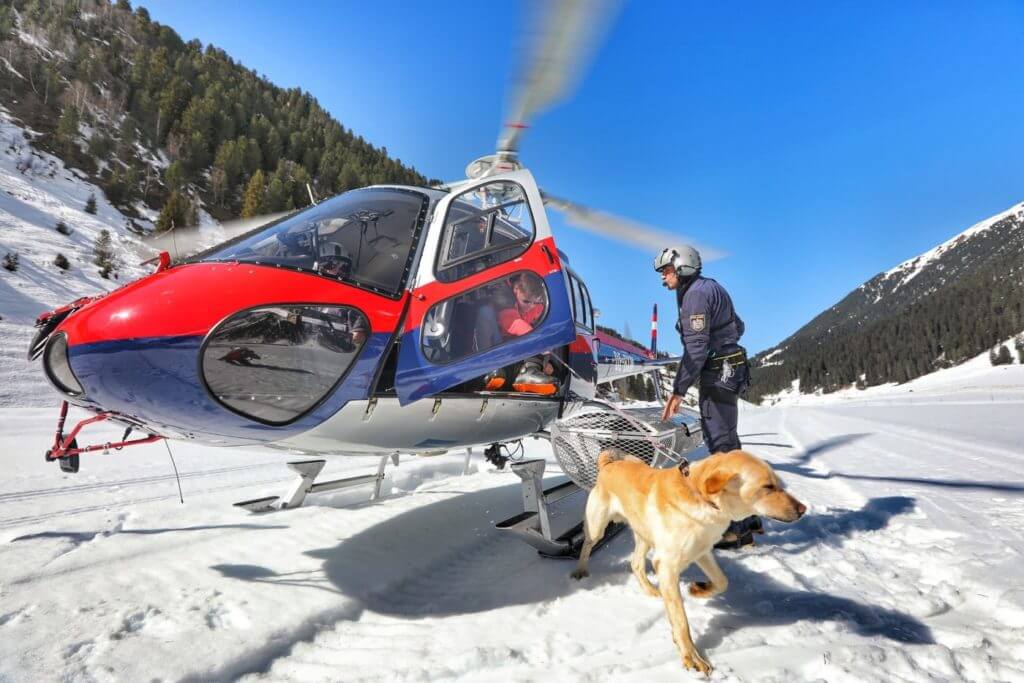
It’s the last weekend of the skiing season with gorgeous weather attracting hundreds of ski touring fans, but a Tirolean phenomenon — the warm wind called Fohn — makes for a somewhat bumpy flight. Passing through the valley we fly over several groups of ski tourers, none of them indicating that help is needed. Then we spot a skier who keeps pointing toward the steep slopes above us.
Schlager performs a toe-in landing on a three-foot-wide ski route at the bottom of the valley so that Markart can ask for more details from the skier in person. We learn that a group was on an uphill climb when an avalanche went off just few meters below them. Scared, they called for help. Soon we have visual contact with them. In such cases with no injuries, it is generally Police Air Support who rescues people from the alpine terrain.
“We fly to every reported avalanche with possible victims, pick up uninjured people but also dead bodies, and perform the whole spectrum of search-and-rescue tasks,” Schlager explains as we head toward the group of stranded skiers. “It’s very often that we’re coming to a scene of an accident after the patient has been evacuated by a HEMS [helicopter emergency medical services] machine to collect his equipment or to do some photo documentation for further investigation.”

Assessing the 30- to 40-degree terrain where the skiers are located, Schlager concludes, “That’s no-go for a hovering pick-up.” We spiral back down to the valley floor to prepare for a fixed-line rescue. Schlager lands but keeps enough collective pulled in to keep the machine light on the old, deep, and unstable snow. Markart and I unpack the 20-meter (65-foot) rope with trapezes and evacuation triangles; when everything is ready, Markart attaches the line to the hooks of the B1, and Schlager lifts off.
As the silver Ecureuil appears smaller and smaller above our heads, the rope tightens up and we’re smoothly lifted off towards the scared ski tourers grouped around a rock massif. The evacuation procedure is seamless and our B1 keeps flying back and forth between the rock and the bottom of the valley carrying Markart plus two skiers at a time, most of them wearing their own climbing harnesses.
In the final lift, we collect their skis and backpacks, then Markart takes down the names and personal data of our rescued friends. We unhook and coil the rope, place the rescue equipment back in the baggage compartment, and wave goodbye to the skiers, who will make their way back down the valley on their own. Eighty minutes after we took off, we return to the base in Innsbruck. By the end of the day, we will have completed five of these avalanche missions.
Birth of the ‘dragonfly’
Helping those in need is something that the Austrian Police Air Support unit has been doing for more than 60 years. The call for coordinated rescue operations in Austria came after an avalanche accident in 1953 was followed only a year later by heavy floods in the Gastein Valley. In 1955, a so-called “Department 27” was set up under the Ministry of the Interior, and in autumn of that year a military aviation base in Langenlebarn hosted the first police flying course.
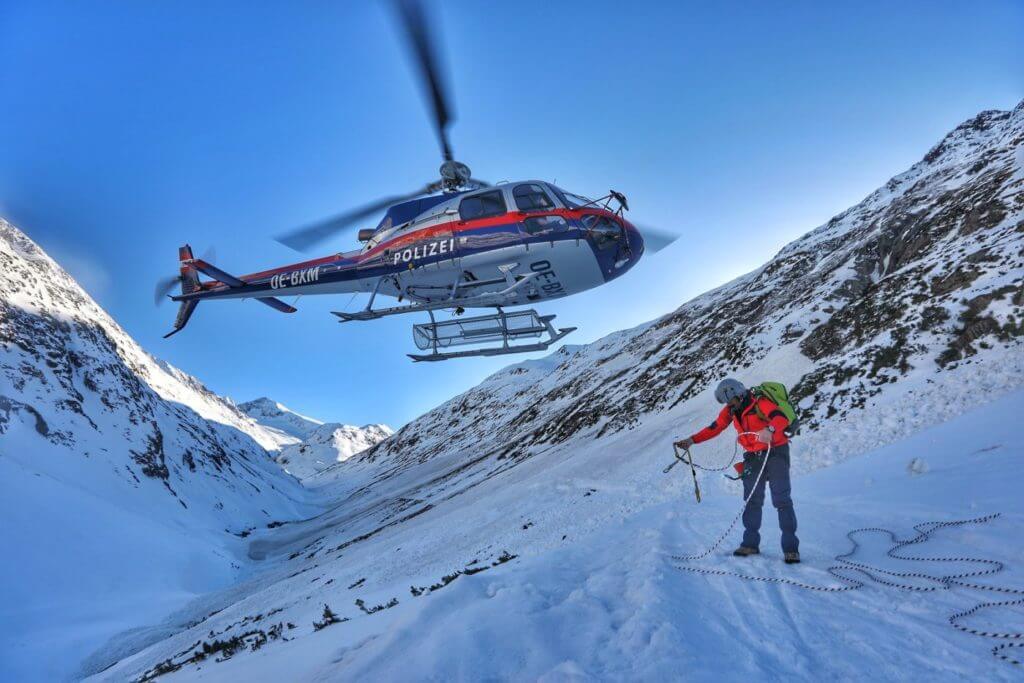
However, the first police air rescue mission in Austria was not performed by helicopter. In March 1956, police pilot and inspector Erhard Landl transported an injured skier from a high alpine location in Kuthai to Innsbruck on board a Piper airplane equipped with skids for landings in snowy terrain. (Another fixed-wing record came in 1960, when a police airplane landed near Adlersruhe at some 3454 meters/11,332 feet above the sea level near Austria’s highest peak, Grossglockner.)
This help from above quickly became a key element of rescues in the Austrian Alps, with their hundreds of peaks and countless tourist and climbing routes in remote locations. The first two Austrian Police Air Support bases were established in Innsbruck and Salzburg in 1956, followed by a base in the Austrian capital of Vienna (Meidling) in 1957, and one in Klagenfurt in the south of the country in 1959.
The very first helicopter to enter service with Austrian Police Air Support was an Agusta Bell 47 (OE-BXB) in 1956. However, fixed-wing aircraft played a dominant role in the early stages of the unit until the first Bell 206B JetRanger entered service in 1967. Thus was helicopter rescue born in Austria, although still in a rather unorganized form. Two more bases were set up in in Graz and Hohenems in Vorarlberg between 1966 and 1968, with a final base established in Linz in 1975. The eight helicopter bases in the Austrian Police’s network (including a second base in Vienna) were given the call signs “Martin 1” through “Martin 8.”
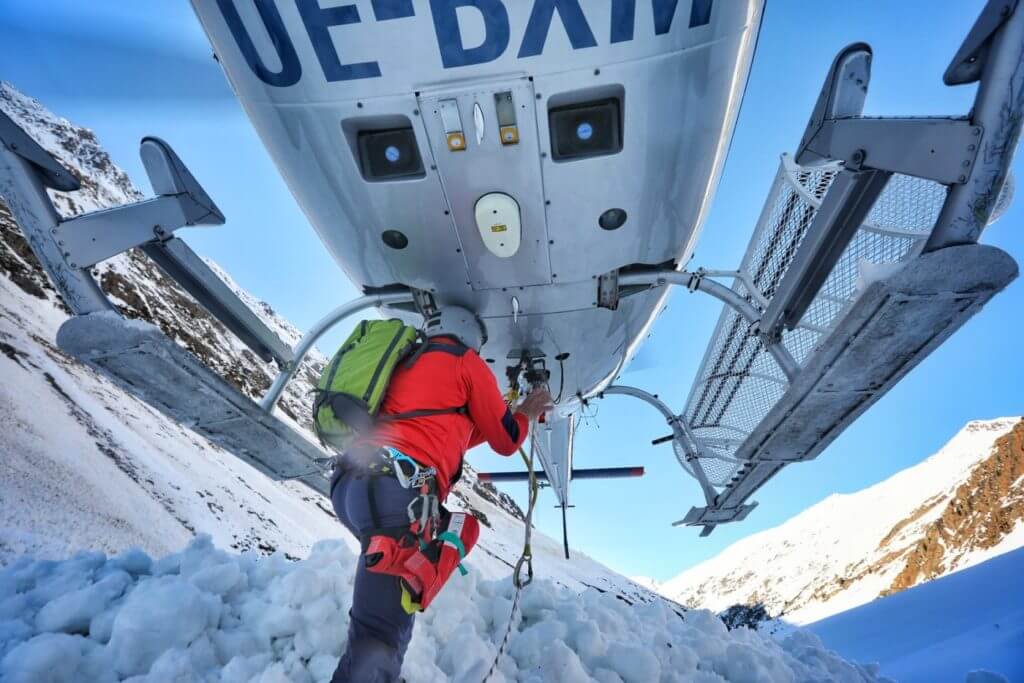
Not only did the Austrian police pioneer high-altitude landings in the Alps, but two inspectors and helicopter pilots from the Innsbruck base, Peter Strasser and Norbert Winter, developed special fixed-rope helicopter rescue techniques that in various forms are still used today for extractions in locations where landing is not possible. These rescue capabilities were enhanced with the upgrade to Aérospatiale (now Airbus Helicopters) AS350 B1 and twin-engine AS355 N and F2 helicopter models.
The 1980s also brought a medical aspect into the Austrian Police Air Support’s rescue tasks. Initially, doctors would join air crews only for medical calls; later, medical personnel were added as full-time, on-duty crew members. However, as the new millennium approached, the private automotive club OAMTC took over HEMS tasks and police helicopters started focusing on more than just rescue. After leaving the HEMS field, Austrian Police helicopters abandoned their historical call sign of “Martin,” which is now being used by Heli Austria’s helicopter emergency medical service Martin Flugrettung in Salzburg and Tirol (see p.62, Vertical 911, Fall 2015). Instead, the police helicopters adopted the call sign “Libelle”, meaning “dragonfly,” which they still use today.
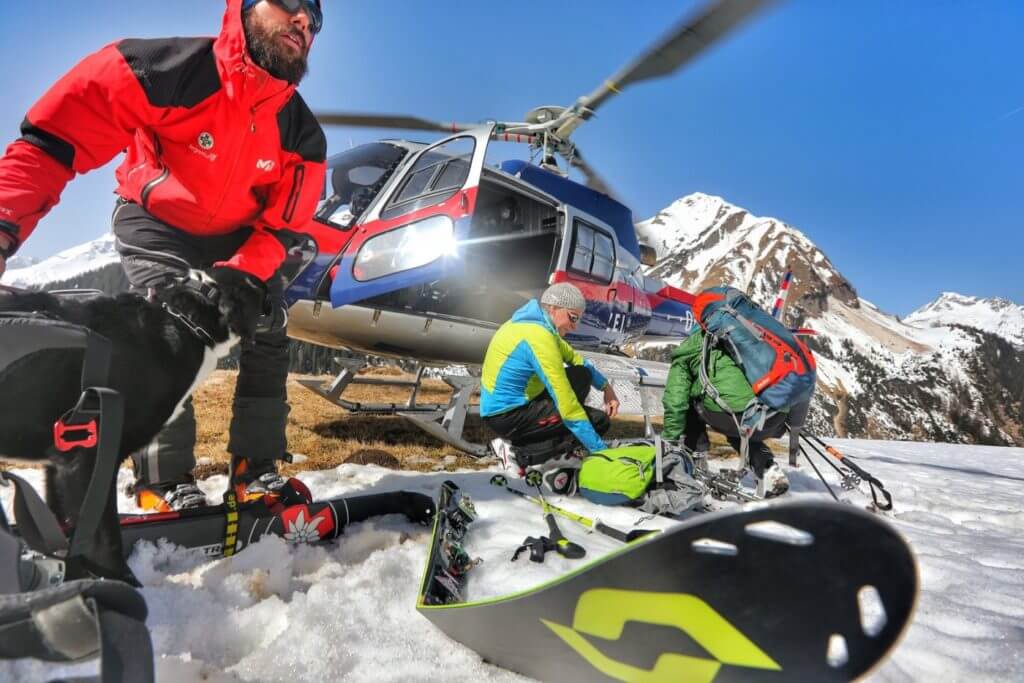
In 2008 and 2009, the Austrian Police Air Support unit received eight brand-new Airbus EC135 P2+ twin-engine helicopters as part of an upgrade that also included the acquisition of an AS350 B3. Today, its fleet consists of 17 helicopters, including four new Airbus H135s (to replace its AS355 Ns) and two H125s on order. The EC135 P2+ represents the backbone of the unit’s SAR operations, with the AS350 B1 and B3 being used in mountain areas due to the better performance of single-engine aircraft at high altitudes. The unit employs 44 pilots as well as 20 technicians who are responsible for aircraft maintenance.
Help from above
Rescue still remains among the top tasks of the Austrian Police Air Support unit today, but only when medical services are not required, as with our evacuation of stranded skiers. Each of the unit’s eight bases has a helicopter, pilot, and operator-rescuer ready to respond to rescue calls anytime between sunrise and sunset.
For night missions, the unit flies with two pilots and a camera operator in its EC135 P2+ helicopters, which are equipped with forward-looking infrared (FLIR) cameras and Spectrolab SX-16 Nightsun spotlights, plus night vision goggles. These extra machines based in Vienna, Salzburg, and Klagenfurt are not equipped with rescue and climbing accessories, as their primary missions involve monitoring and supporting police forces on the ground. They are located at the same bases as the rescue machines, with the exception of the FLIR-equipped EC135 in Vienna, which is based at Vienna International Airport in Schwechat. This aircraft takes off up to six times daily in order to monitor the area and conduct classified security flights in accordance with international agreements.

“Apart from this, the helicopter is still on duty whenever a scramble message comes from any part of the region that belongs to its range,” explained Patrick Fritz, a young but nonetheless experienced pilot. “The FLIR helicopters are on duty 24/7. The crew exchanges always at 7 in the morning and 7 in the evening. Our pilots rotate through the bases according to the roster.”
Fritz is one of the flying instructors for the new pilots that Austrian Police Air Support trains in-house. He explained, “Our school under the direction of a colleague, Michael Korvas, has one Bell 206B3 JetRanger that is being used for training purposes solely. It’s a great machine. We equipped her with upgraded landing skids, as we did with all of our EC135 P2+s. They’ve got the tallest landing skids possible and it’s fantastic, especially when landing in the fields or uneven terrain.”
In a land with so many mountainous areas, firefighting from the air is extremely important, and this is another domain of Austrian Police Air Support. Using the popular Bambi Bucket, the unit flies many training exercises and real missions in cooperation with professional and volunteer firefighters. Beyond dropping water, the helicopters perform wide variety of tasks when it comes to wildland firefighting, including transporting people and material and monitoring the progress of fires.
Other duties include assisting during flooding events, responding to traffic accidents, and visiting crime scenes in remote locations. The occasional need to photograph crime scenes or evacuate dead bodies necessitates that all crewmembers be police officers.
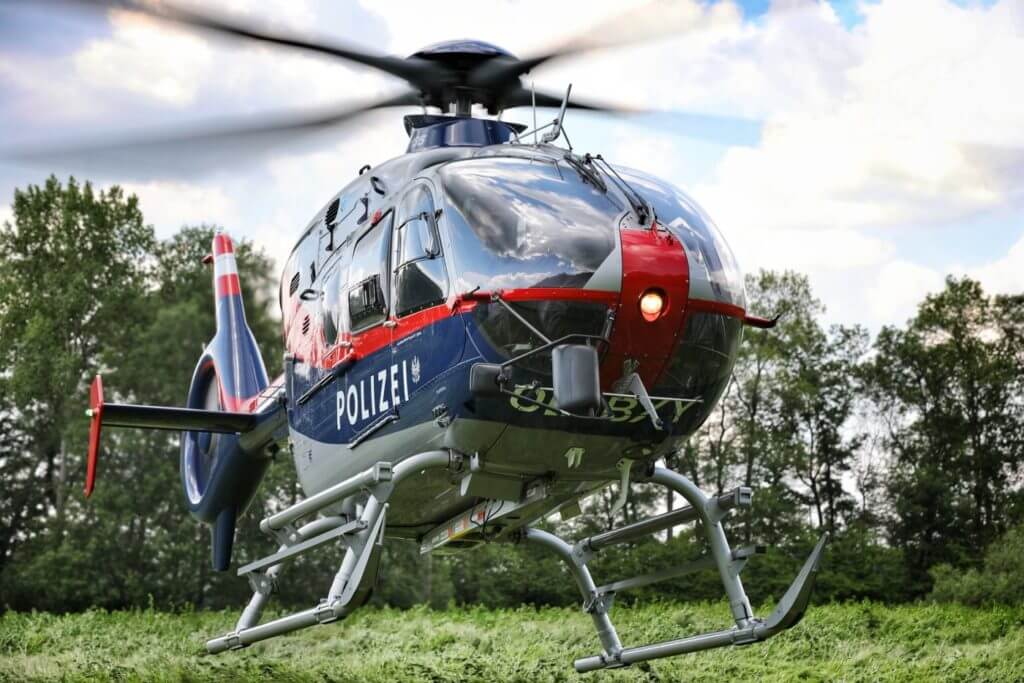
“Each operator-rescuer has to be a police mountain guide,” said Markart, who like his colleagues in the role assumes multiple duties on the aircraft in addition to serving on the ground. “We have to be policemen, so-called Alpin police. There is a team for each base that rotates and usually spends one or two days a month serving on the helicopter, otherwise we perform all the regular tasks of the policemen. The exception is the fixed team of FLIR operators at Vienna International Airport.” Special duties for these officers include law enforcement tasks in cooperation with the Austrian Police’s Cobra commando unit, and providing monitoring and support for VIP movements and large public events such as the Vienna City Marathon or European soccer championships.
As I discovered during my own time with Austrian Police Air Support, the unit’s helicopters can be flying almost nonstop during the busy seasons. But in truth there is barely a low season for Libelle in Austria, since the main task and bottom line of all the unit’s helicopter flights is to look after the safety of the country’s inhabitants — regardless of the time or place.





